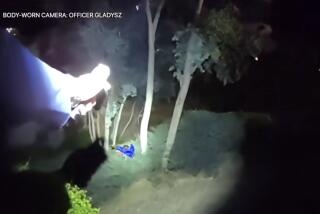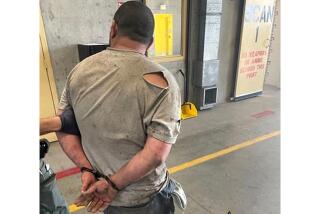Peace Claims He’s ‘Ritual Victim’ of Spat in Capitol : D.A. Orders That Police Pistols Used in Slaying Be Turned Over to Defense
In the first official attempt to resolve a growing controversy over the shooting of a Mexican border bandit, the district attorney’s office Friday ordered San Diego police to make the pistols used in the shooting available to a defense attorney who alleges the bandit was executed.
The district attorney also ordered homicide investigators to recreate the shooting for the defense team, which plans to run ballistics tests on the weapons.
Deputy Dist. Atty. Dan Williams said his office “was most anxious to resolve the issue.” Williams said he was acting on the request of defense attorney Jose Tafolla, who has charged that Julio Arroyo Zaragoza, 33, was shot in the forehead at point-blank range on May 4 by police after he was captured. Tafolla is representing Arroyo’s brother, Jaime Arroyo Zaragoza, 23, who was charged with robbery and attempted murder in the incident.
Julio Arroyo’s body was exhumed from a Tijuana cemetery last week for an autopsy by Tijuana coroner Dr. Gustavo Salazar, who reported that Arroyo died from a bullet fired at point blank range. Defense pathologist Dr. Hormez Guard, who observed the autopsy, said laboratory tests conducted last week in San Diego on tissue samples taken from Arroyo’s skin and skull showed traces of gunpowder, proving Arroyo was shot by a gun that was placed close to his forehead.
In another development in the case, Guard and County Coroner David J. Stark met Friday morning to compare evidence, and agreed that tissue samples of the victim’s brain kept by the coroner’s office showed bone particles and traces of a “black foreign substance.” Guard said the dark deposits suggested the presence of gunpowder, but Stark said that while he could not identify the deposits, he did not think they are gunshot residue.
“The deposits looked like a carbon material. There’s no other way that carbon material can go deep into the brain other than from gunpowder,” said Guard. Guard and Salazar concluded that Arroyo died from a contact wound, a wound suffered when a gun barrel is placed on the skin or very near to it.
Stark said he “was not sure what the particles are,” but said that he and three county pathologists who studied the brain tissue are “sure they’re not gunshot residue.” On Wednesday, Stark said that laboratory tests conducted by county pathologists on the brain tissue support a police report that said Arroyo died from a 9-millimeter bullet fired from 30 feet to 40 feet.
After Friday’s meeting, both sides said the issue will have to be decided by a third party that will eventually be hired to examine all of the tissue samples under a more sophisticated electron microscope. Stark and Williams will meet with Guard and Tafolla next week to agree on an independent forensic pathologist to examine the conflicting evidence in the case.
“I was pleased with the meeting. We studied their slides, and we’re more firm than ever in our argument that this was not a contact wound. Our pathologists did not identify gunpowder on the slides,” said Stark.
However, both Tafolla and Guard said that two of the three county pathologists who examined the defense slides refused to rule out the presence of gunpowder. Guard said that Dr. David M. Katsuyama was the only pathologist who said he was convinced that the tissue samples did not contain gunpowder. Katsuyama conducted the first autopsy on Arroyo’s body on May 6.
Tafolla and Guard said the other two pathologists, supervising pathologist Dr. Robert Bucklin and Dr. Joseph Eisle, did not rule out anything. The two men could not be reached for comment Friday.
“They really did not discount the possibility that he (Arroyo) died from a contact wound,” said Guard. “They saw my slides, but they just didn’t want to say anything.”
But Williams, who has prosecuted homicide cases in which victims died from contact wounds, said the slides convinced him that Arroyo was shot from 30 feet to 40 feet away.
“I have seen nothing yet to lead me to believe that their allegations are true,” said Williams.
Police said that Julio and Jaime Arroyo and an unidentified third suspect were robbing illegal aliens in the canyons that straddle the international border on the night of May 4. The trio were confronted by the Border Crimes Prevention Unit, composed of San Diego Police and Border Patrol agents.
According to a police report, Julio Arroyo fired at the officers and in a wild exchange of gunfire was hit in the middle of the forehead at the hairline with a bullet fired by Officer Cesar Solis. Jaime Arroyo was not injured, and the third suspect escaped. Jaime Arroyo has told family members and Tafolla that police killed his brother after he was wounded in the left calf and disarmed.
On Friday, Tafolla said he was assured that next week police will turn over the pistols used by the officers in the shooting for testing by a ballistics expert he has hired. Tafolla said the ballistics test will prove that Arroyo died from a contact wound and will show who fired the fatal shot.
After the shooting, homicide Lt. Paul Ybarrondo said the fatal shot was fired by agent Fred Stevens, who was shot five times by Arroyo. Stevens, who was saved by an armored vest and is back on duty, emptied his .357 magnum revolver in the gunfight. Later, Ybarrondo said that ballistics tests showed the fatal bullet was actually fired by Solis.
Tafolla said the visit to the scene will give him and defense investigator Hank Contreras a clearer understanding of where the agents and Julio Arroyo were standing during the gun battle. The incident occurred about 1/2 mile east of the San Ysidro port of entry and mile north of the border.
More to Read
Sign up for Essential California
The most important California stories and recommendations in your inbox every morning.
You may occasionally receive promotional content from the Los Angeles Times.










